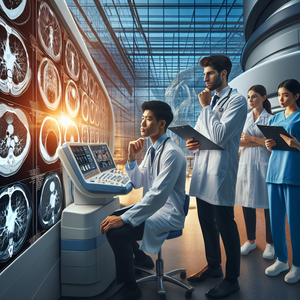LinkedIn Mastery for Radiologic Technologists

LinkedIn transcends the traditional notion of an online resume. It is a dynamic platform that empowers professionals to connect with industry leaders, share insights, and demonstrate their expertise. For radiologic technologists, effectively leveraging LinkedIn can open doors to job opportunities, collaborations, and ongoing professional development. A survey by Jobvite underscores this importance, revealing that 87% of recruiters utilize LinkedIn as part of their hiring process. This statistic highlights the necessity for RTs to cultivate a standout presence on the platform.
Crafting an Optimized LinkedIn Profile
The first impression on LinkedIn is crucial. A professional headshot can significantly enhance your profile's appeal. Select a clear, high-quality image that reflects your professionalism. Complement this with a customized banner image that embodies your field or career aspirations, such as a depiction of advanced imaging technology.
Compelling Headline
Your LinkedIn headline should extend beyond merely stating your job title. It should encapsulate your areas of expertise and career ambitions. For instance, instead of simply listing "Radiologic Technologist," consider a more descriptive headline like "Dedicated Radiologic Technologist Specializing in MRI and CT Imaging," which conveys your specialization and commitment.
Detailed Summary
The summary section serves as your personal narrative. Here, you can showcase your experiences, skills, and the passion that drives your career in radiologic technology. Incorporate relevant keywords throughout this section to improve your profile's discoverability in search results. For example, you might mention specific technologies you are skilled in, such as “digital radiography” or “ultrasound imaging.”
Experience and Education
Outline your professional history clearly, detailing specific roles, responsibilities, and accomplishments. Including relevant certifications and educational achievements is essential. Use bullet points for clarity, and whenever possible, quantify your achievements. For instance, stating, "Performed over 1,000 imaging procedures annually" helps demonstrate your experience and efficiency in the field.
Skills and Endorsements
Adding key skills that are pertinent to your profession is vital for showcasing your competencies. Skills such as "Patient Care," "Radiographic Imaging," and "Team Collaboration" should be highlighted. Actively seek endorsements from colleagues and supervisors, as these serve as testimonials to your abilities.
Building a Professional Network
Begin by connecting with colleagues, classmates, and industry professionals. Personalize your connection requests with a brief message explaining your interest in connecting. This approach not only increases the likelihood of acceptance but also fosters authentic relationships.
Join Relevant Groups
LinkedIn is home to numerous groups focused on radiologic technology and healthcare. Engaging in these groups can facilitate knowledge sharing and keep you informed about industry trends and developments. Active participation can also enhance your visibility within the community.
Engagement is Key
To increase your visibility, actively engage in discussions, share articles, and comment on posts relevant to your field. This not only positions you as a knowledgeable member of the community but also keeps you top-of-mind for potential employers.
Engaging with Relevant Content
Regularly posting articles, insights, or case studies related to radiologic technology can help you showcase your expertise. For example, consider writing about recent advancements in imaging technology or sharing tips on patient care best practices. Such contributions can spark meaningful conversations with fellow professionals.
Follow Influencers and Organizations
Staying informed is crucial. Follow industry leaders, organizations, and relevant hashtags to gain insights into the latest trends and discussions. Engaging with their content can also provide opportunities to connect with other professionals in your field.
Utilize LinkedIn Learning
LinkedIn Learning offers a plethora of courses related to radiologic technology. Completing these courses and displaying them on your profile demonstrates your commitment to ongoing professional development and enhances your qualifications.
Optimizing your LinkedIn profile is a critical step for radiologic technologists seeking to advance their careers. By crafting an appealing profile, building a robust professional network, and engaging with relevant content, you can significantly enhance your visibility and attract potential employers. In a competitive job market, mastering LinkedIn can be the key to unlocking new opportunities and achieving your professional goals. Remember that your LinkedIn profile is a living document; keep it updated and actively engage with your network to ensure continued growth in your career as a radiologic technologist. By embracing these strategies, RTs can effectively navigate the digital landscape and stand out in their field.
MRI Technologist
Hospitals, imaging centers, and specialized clinics
Core Responsibilities
Conduct MRI examinations, ensuring patient safety and comfort during procedures.
Collaborate with radiologists to interpret images and provide accurate diagnostic information.
Maintain MRI equipment and perform routine quality checks to ensure optimal performance.
Required Skills
Proficiency in MRI technology and techniques.
Strong knowledge of anatomy and patient care protocols.
Certification from the American Registry of Radiologic Technologists (ARRT) in MRI.
CT Technologist
Hospitals, diagnostic imaging facilities, and outpatient clinics
Core Responsibilities
Perform CT scans on patients, administering contrast agents as needed while monitoring vital signs.
Work closely with physicians to provide precise imaging pertinent to patient diagnosis.
Document and maintain patient records and imaging results in compliance with healthcare regulations.
Required Skills
Expertise in computed tomography (CT) imaging and protocols.
Excellent communication skills for patient interaction and teamwork.
Current ARRT certification in CT imaging.
Ultrasound Technologist (Sonographer)
Hospitals, outpatient imaging centers, and specialty clinics
Core Responsibilities
Perform diagnostic ultrasound examinations, including abdominal, pelvic, and obstetric scans.
Analyze and document ultrasound results, providing preliminary findings to physicians.
Ensure proper maintenance and calibration of ultrasound equipment.
Required Skills
In-depth knowledge of ultrasound technology and patient care techniques.
Certification from the American Registry for Diagnostic Medical Sonography (ARDMS).
Strong analytical skills to interpret ultrasound images effectively.
Radiologic Technologist (Interventional Radiology)
Hospitals, surgical centers, and specialized radiology practices
Core Responsibilities
Assist physicians during minimally invasive procedures using fluoroscopic imaging guidance.
Prepare patients and ensure compliance with safety protocols during interventional procedures.
Maintain meticulous records of procedures performed and assist in post-procedure care.
Required Skills
Advanced knowledge of interventional radiology techniques and imaging systems.
Strong attention to detail and ability to work in a high-pressure environment.
ARRT certification with a focus on radiography and interventional procedures.
Radiology Manager
Hospitals, healthcare systems, and outpatient imaging facilities
Core Responsibilities
Oversee daily operations of the radiology department, ensuring compliance with health regulations and standards.
Manage staff, including hiring, training, and performance evaluations of radiologic technologists.
Develop departmental budgets, manage resources, and implement quality improvement initiatives.
Required Skills
Experience in radiologic technology with a comprehensive understanding of imaging modalities.
Strong leadership and organizational skills.
A bachelor's degree in a related field, along with ARRT certification.


